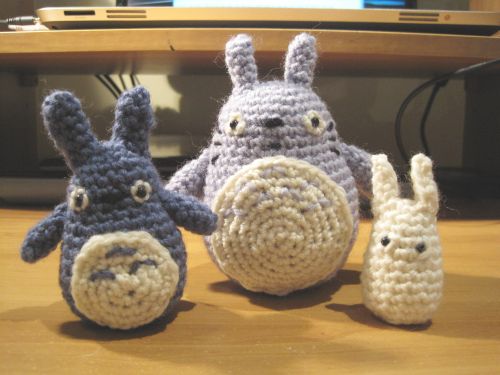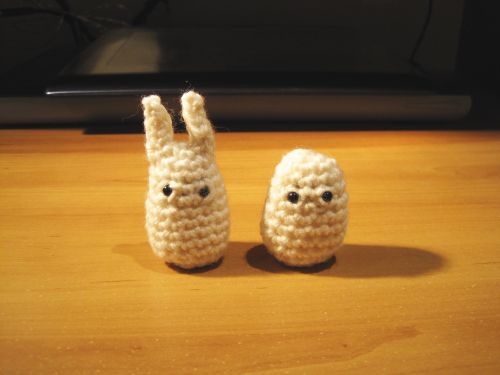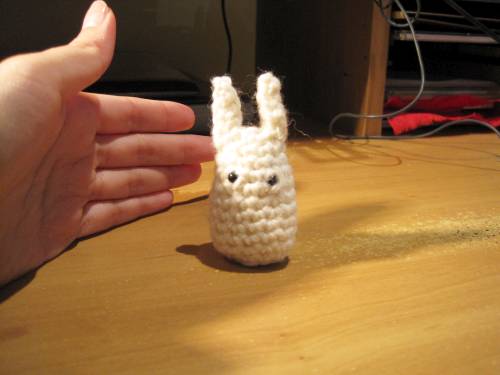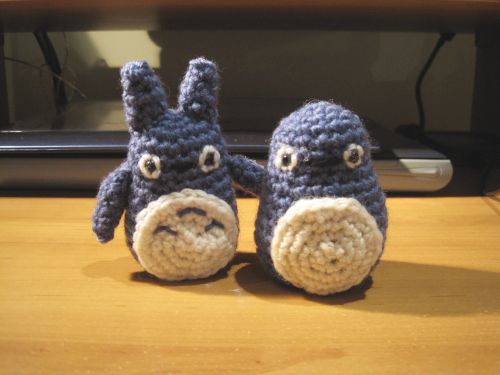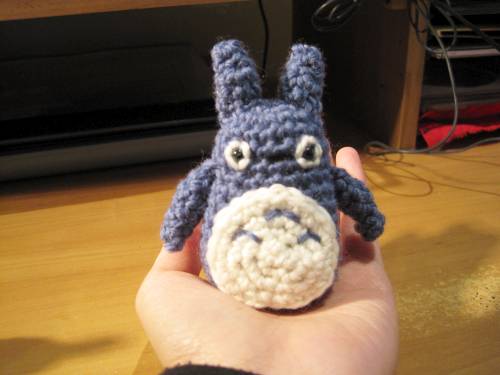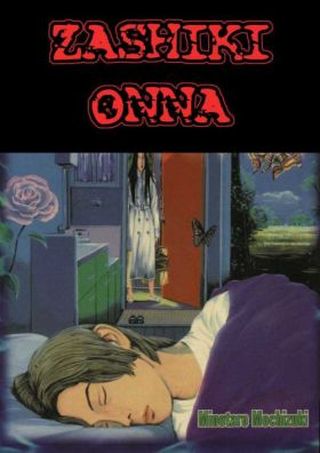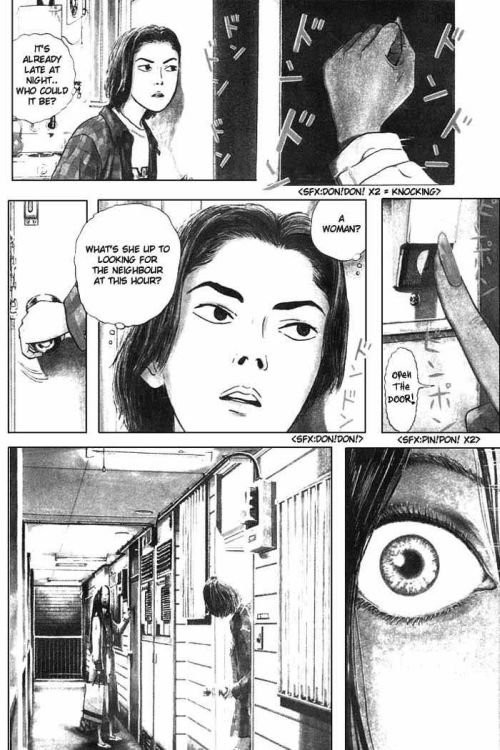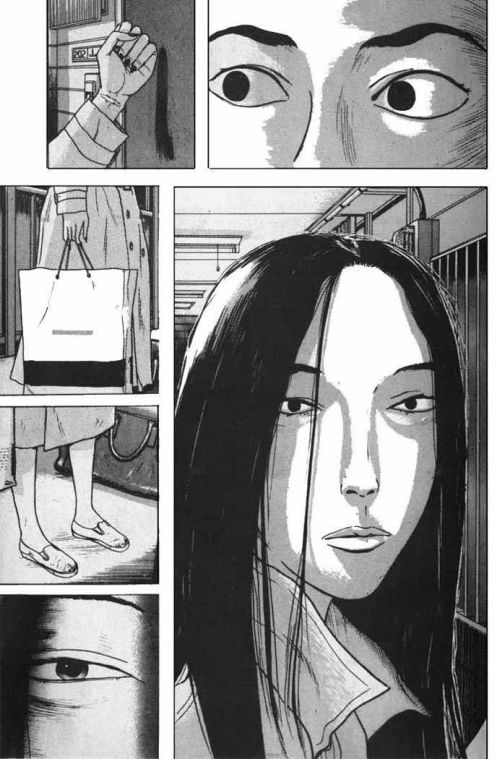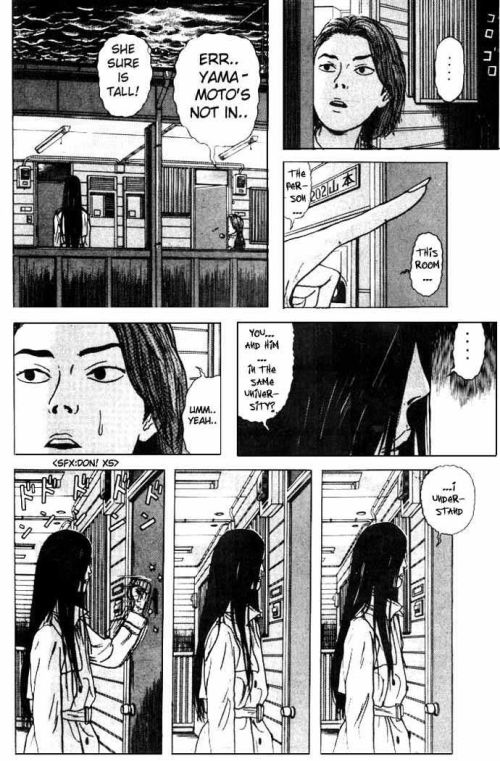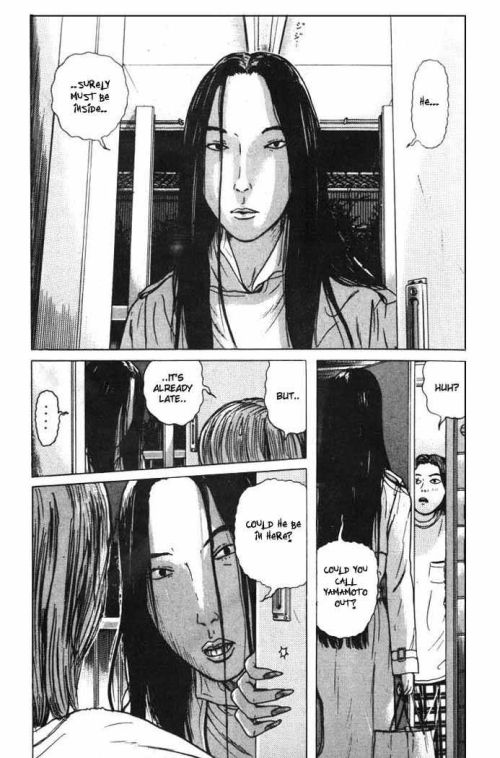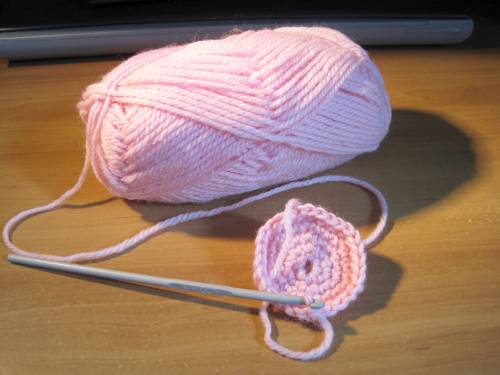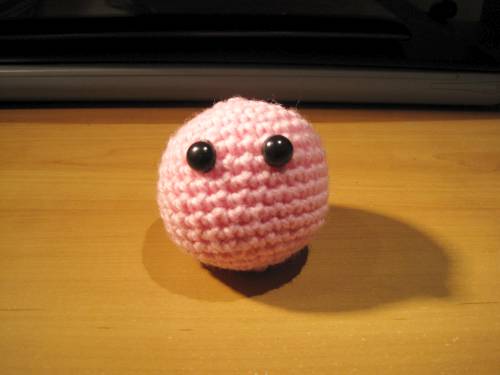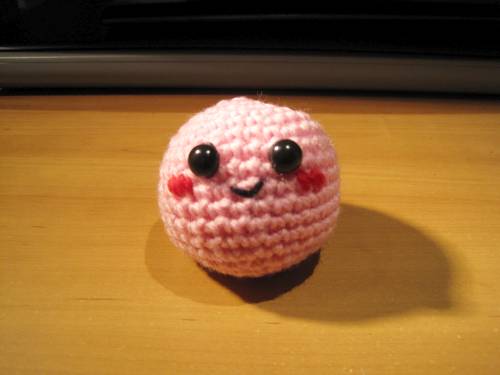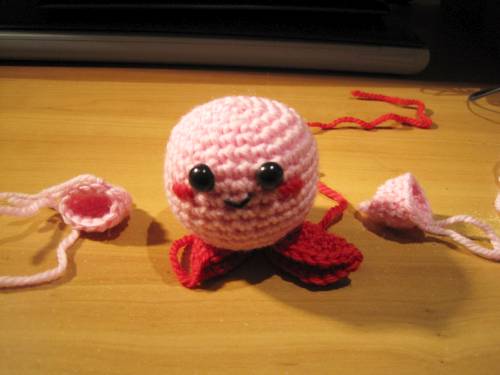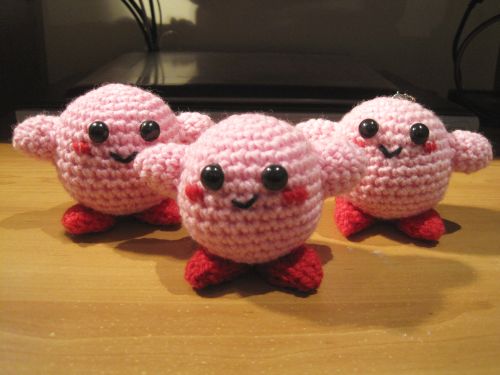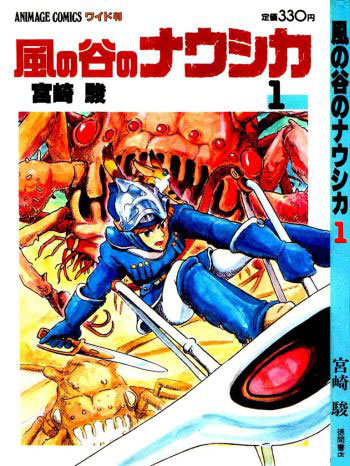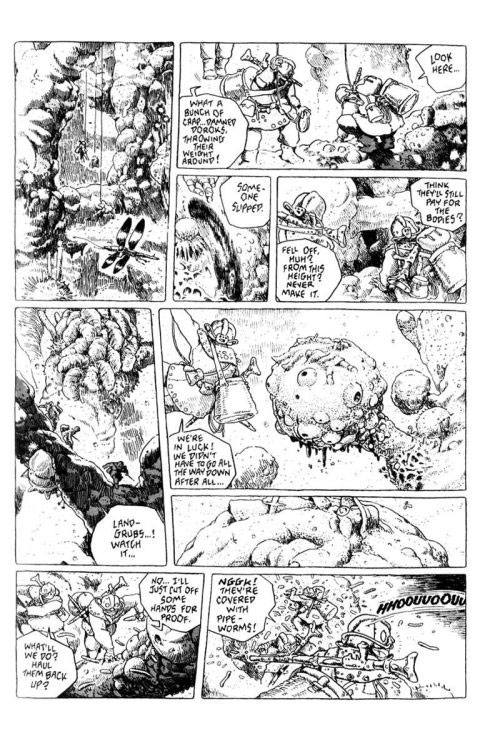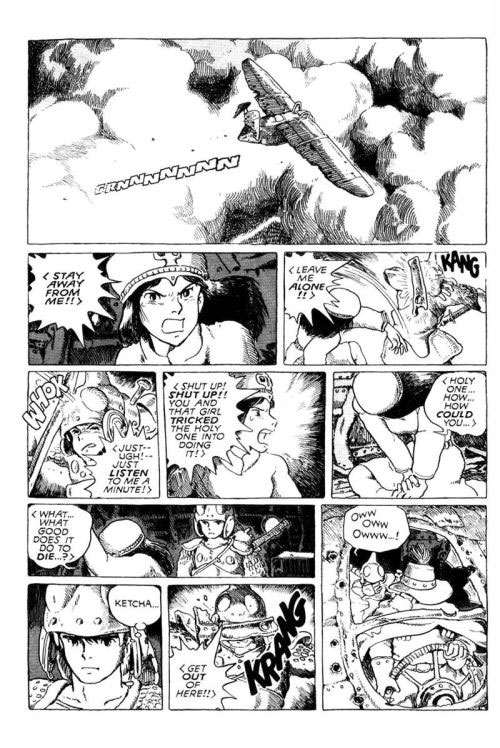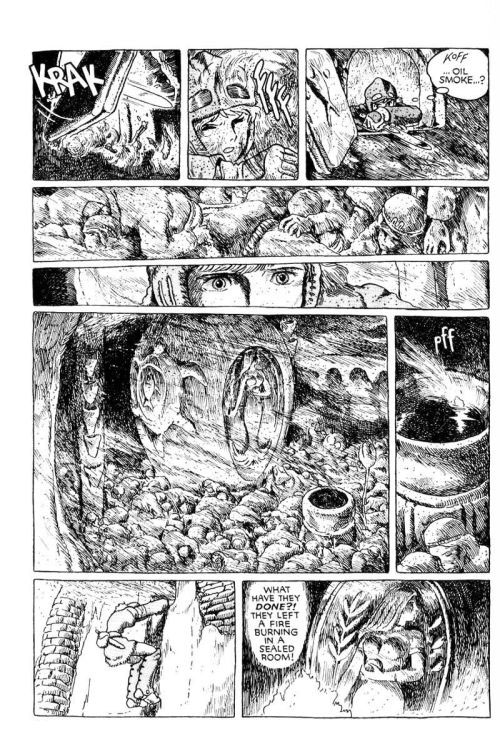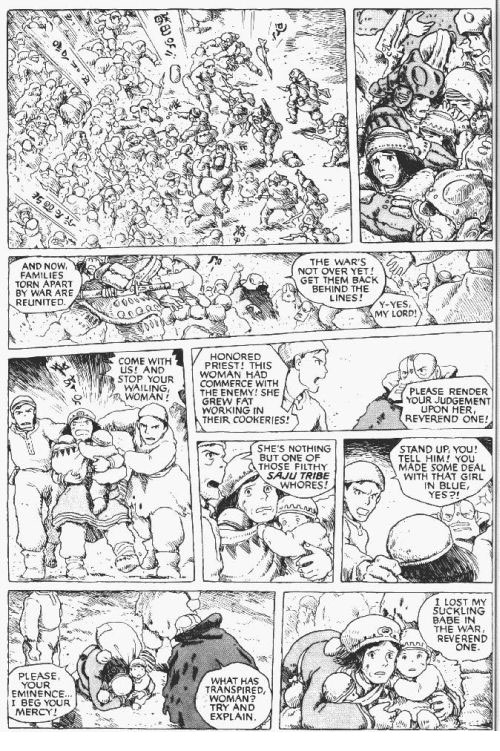This week I made good headway on Small Shen, and is halfway through Chapter 3 pencils. If you’re looking for some art updates from this last post I did, I did an interview on sigmatestudio.com where I showed some finished art samples from Chapter 1. Thanks to Stephen for the interview!
This week, I get to put up another free crochet pattern, adding to my budding pattern collection which so far includes the Red Angry Bird and the White Angry Bird. It’s a fan-favourite, the Blue and White Totoros from the seminal Studio Ghibli animations My Neighbour Totoro. If you’re a Hayao Miyazaki fan, you’ll know and love these furry critters. I also have the “large” grey Totoro pattern, which is here.
These crochet patterns are quite small, and you can see the size of the Totoros in relation to my hand. The reason why they’re so small is because I don’t want to crochet large amigurumis, since they take up a lot of time. Since the giant grey Totoro is 38 stitches at its widest point, it makes sense that the smaller Totoros are… small. Either way, these won’t take long to do!
Blue and White Totoro Pattern
Here’s a list of what I used to make this crochet. It’s not a definite list, so feel free to use whatever you have, as long as it’s appropriate. It’s crocheted in the round, like most amigurumi, so only basic crochet skills are required.
NB. This pattern is created by me, so please give a link back to me if you want to use it or if you want to sell your crochet. Please give credit where it’s due. I should also that I don’t own the copyright to these characters – obviously Studio Ghibli does.
- White, black and blue 8 ply yarn
- 4mm crochet hook
- Two pairs of 3mm black safety eyes – 6060 from Etsy is a good place to buy these
- Large sewing needle, to sew the bits and pieces together
Crochet Abbreviations
Here are a list of the abbreviations I use, and what they mean. These are pretty standard, so if you know how to crochet, this won’t be hard to decipher:
- ch – chain
- sc – single chain
- dec – decrease
- * – beginning/end of a repeating part of the pattern
White Totoro Pattern
White Totoro Body (Make 1, white)
Rnd 1 – Ch 2, 6 sc in 2nd chain away from hook (Magic Ring method)
Rnd 2 – *2 sc in next stitch*, repeat 6 times (12 stitches)
Rnd 3-4 – sc (12 stitches)
Rnd 5 – *2 sc in next stitch, 3 sc*, repeat 3 times (15 stitches)
Rnd 6-9 – sc (15 stitches)
Stuff the body now, and add 3 mm safety eyes
Rnd 10 – *dec 1, 3 sc*, repeat 3 times (12 stitches)
Rnd 11 – *dec 1 through BACK loops only*, repeat 6 times (6 stitches)
Bind off, and using a sewing needle, sew a few white yarn stitches around the safety eyes.
White Totoro Ears (Make 2, white)
Rnd 1 – Ch 5
Rnd 2 – sc, then ch 1
Rnd 3 – sc
Bind off, then using a sewing needle, sew the longer edges together to make a thin tube.Sew one end together, then sew the other end to the top of the Totoro, to make the long thin ears.
White Totoro Tail (Make 1, white)
Ch 2, 4 sc (Magic Ring method) and then sew onto the Totoro’s butt area.
Done right, this will help prop upBaby Totoro
Blue Totoro Pattern
Blue Totoro Body (Make 1, blue)
Rnd 1 – Ch 2, 6 sc in 2nd chain away from hook (Magic Ring method)
Rnd 2 – *2 sc in next stitch*, repeat 6 times (12 stitches)
Rnd 3 – *2 sc in next stitch, sc 1*, repeat 6 times (18 stitches)
Rnd 4 – 6 – sc (18 stitches)
Rnd 7 – *2 sc in next stitch, sc 5*, repeat 3 times (21 stitches)
Rnd 8 – *2 sc in next stitch, sc 6*, repeat 3 times (24 stitches)
Rnd 9 – 13 – sc (24 stitches)
Stuff the body now, and add 3 mm safety eyes
Rnd 14 – *dec 1 in back loops ONLY*, repeat 12 times (12 stitches)
Rnd 15 – *dec 1*, repeat 6 times (6 stitches)
Bind off, and thread the yarn through the Totoro. Using a sewing needle, sew a few white yarn stitches around the safety eyes. Then using black yarn, sew the nose on.
Belly (Make 1, white)
Rnd 1 – Ch 2, 6 sc in 2nd chain away from hook (Magic Ring method)
Rnd 2 – *2 sc in next stitch*, repeat 6 times (12 stitches)
Rnd 3 – *2 sc in next stitch, sc 1*, repeat 6 times (18 stitches)
Rnd 4 – *2 sc in next stitch, sc 2*, repeat 6 times (24 stitches)
Bind off, and sew the white belly onto the bottom front of the Totoro. Using blue yarn, sew three “arrows” on its chest.
Blue Totoro Arms, Ears and Tail (Make 5, blue)
Rnd 1 – Ch 2, 4 sc in 2nd chain away from hook (Magic Ring method)
Rnd 2 – *2 sc in next stitch, sc 1*, repeat 2 times (6 stitches)
Rnd 3 – 6 – sc (6 stitches)
** For the arms, sc for two extra rows **
Bind off, and stuff with a small bit of stuffing. Sew the arms, ears and tail onto the proper places of the Totoro.
And Viola! Here you have the two small Totoros, next to my hand to show their sizes.






